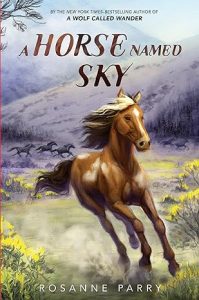Bringing the Wilderness to Life in Words and Pictures by Rosanne Parry
Bringing the Wilderness to Life in Words and Pictures by Rosanne Parry

Photo by Brian Garaths
The thing I have loved the most about working on the Voice of the Wilderness books is working with an illustrator. And when we began back in 2019 with A Wolf Called Wander, the notion of creating an abundantly illustrated middle grade novel from the point of view of a wolf was a rare choice, as fully illustrated middle grade books haven’t been common for many years. But the initial publisher, Andersen Press, was keen to give it a try. They found the Oregon wilderness too exotic for the world-wide audience they were hoping to reach, so they found Mónica Armiño of Madrid to illustrate A Wolf Called Wander. She created more than 120 pictures large and small. It was a huge gamble for the publisher to make and it paid off spectacularly. The combination of a wolf with a compelling voice in a richly described ecosystem alongside brilliant art has kept that first Voice of the Wilderness book on The New York Times bestseller list for the better part of three years and brought it into translation in 14 countries.
The team at HarperCollins Greenwillow took the reins with A Whale of the Wild illustrated by Lindsay Moore. It hit bookshelves in the middle of the pandemic. All our plans for a splashy roll out were canceled and yet that same combination of an orca with a powerful voice navigating a beautiful and mysterious ecosystem, accompanied by luminous watercolors of life in the Salish Sea, worked its magic again.
In writing the third Voice of the Wilderness story, A Horse Named Sky, I knew Greenwillow would choose an outstanding artist so before I even started writing, as I was researching, I was already thinking of collaboration.
On my research trips to eastern Oregon and western Nevada, I took careful notes and hundreds of photos of the landscape, the particulars of flora and fauna, and that big, changing western sky. Because Kirbi Fagan had so many pieces to create, I tried to lighten the load a bit by providing examples of things she might draw. I also kept a bibliography of books and articles and a list of all the sources I contacted by phone or email to answer specific questions.
For example, you would think that the question of what wild horses eat would be simple. Grass.
So much more complicated!
I saw with my own eyes that horses gobbled up some plants, merely nibbled at others and completely shunned some of them. Fortunately, the University of Nevada had a range specialist I could talk to about native bunch grasses, invasive weeds, and surprising details about sagebrush–a more complex and valuable plant than I first realized.
Laying all that groundwork in the research stage made it much easier to edit the book and respond to questions from the art direction team.
Illustrations make it possible for me to hew closely to the animal point of view. For example, horses are able to see color, but they are much more focused on motion. So, my mustang character calls butterflies “flutters” and rabbits “bounders”. Readers not quite old enough to grasp the intricacies of a horse’s point of view have Kirbi’s illustrations close at hand to help them understand his world.
Being concise is always on my mind. I want to leave room for all the pictures. And space for readers to pause and reflect. I am particularly happy that all my Voice of the Wilderness books have included a map. It would be very hard to make the horse’s location clear in the story without it. What does a horse know about cardinal directions? He knows where the sun rises but not the bird’s eye view of the landscape. Our wonderful map maker, Ryan O’Rourke gave readers a terrific overview of the Virginia Range in Nevada, the Pony Express Trail and the Comstock silver mines. In addition, Greenwillow always makes sure I have space at the end to fill in more detail on the background of the story. It was particularly helpful this time because A Horse Named Sky is historical and there was a lot happening on the Pony Express trail of 1860 that was invisible to a horse.
Here’s the bit of history even a horse could see clearly. There is a Paiute child taken as a slave under the California Indian Act of 1850. Sky and all the mules who live at the Pony Express station where he was held captive can see that he is kind and courageous and is treated terribly by the master of the station. Sky forms a bond with this child and is inspired by his escape. Sky might not understand the reasons for that child’s enslavement, but he can see that freedom is worth the risk and worth the fight. I hope every reader thinks deeply about the freedoms they have and the freedoms they most need to defend. I’m grateful to have such a talented and thoughtful illustrator in Kirbi Fagan help me bring these scenes and themes to light.
Illustrating Sky’s Journey by Kirbi Fagan
Jumping into Sky’s journey was a journey of my own, but I wasn’t alone! Greenwillow and Rosanne were deep into the writing of A Horse Named Sky before I joined the team. I came to the project with a passion for horses, specifically wild horses, so between Rosanne’s captivating words, the team’s help, and one of my favorite animals…. inspiration for bringing the wilderness to life came from every direction.
Sky’s beautifully researched trail (which you can follow along with the map in the novel) made it easy to know which plants and animals I would want to include in the scenes. Weather was one of my favorite elements to work with as this story includes a range of seasons but there is more to the wild than what we can see. I chose to do the illustrations in pastel. It can be soft (even reminding me of a velvety muzzle sometimes). It can also look rough and dry, which is important to capturing the American West. The pastel had a perfect range and I also felt that it flowed well with the previous illustrators’ choices, Lindsay Moore and Mónica Armiño.
Pictures and words together can create moods that neither medium can do on its own. A Horse Named Sky is an action-packed novel, I wanted each roadblock to elevate the tension and have the reader guessing pages before it happens. A looming bird, a storm in the distance or a scuffle of my brush to show a crisp wind. The options available to me as an artist are overwhelming but with collaboration, we all figure out what’s best for the story. Ideas aren’t without limitations. If illustrations are too dark (which is tempting for a dramatic scene!) they can risk lacking detail. Text needs to be read clearly over art and that can limit space and size.
One solution I used was letting the camera angle tell you about the scene. Even how the illustration is cropped can add to the narrative. When a character is in danger, readers will notice the landscape might feel big and looming. Many of the more intimate moments are close-ups and you can see the gentle whiskers. A vantage point can make you worry, the characters aren’t alone.
I’m ecstatic the book is out in the world, I hope you will hear, see, and feel the wild in A HORSE NAMED SKY!
Rosanne Parry is the author of the acclaimed novels A Wolf Called Wander, A Whale of the Wild, Heart of a Shepherd, Second Fiddle, and Written in Stone. She has taught writing at schools, conferences, educational nonprofits, and online at the Loft Literary Center and works as an independent bookseller. She and her family live in an old farmhouse in Portland, Oregon. She writes in a tree house in her backyard.
 Kirbi Fagan is a Michigan-based illustrator who specializes in creating art for readers. She is recognized for her cover art in Adult, YA, and Middle Grade fiction as well as her numerous covers for comic books on projects such as Black Panther/Shuri and Firefly. Kirbi’s first picture book The Summer of the Tree Army by Gloria Whelan was released in 2021. Her first author-illustrated picture book will debut in 2025.
Kirbi Fagan is a Michigan-based illustrator who specializes in creating art for readers. She is recognized for her cover art in Adult, YA, and Middle Grade fiction as well as her numerous covers for comic books on projects such as Black Panther/Shuri and Firefly. Kirbi’s first picture book The Summer of the Tree Army by Gloria Whelan was released in 2021. Her first author-illustrated picture book will debut in 2025.
A HORSE NAMED SKY
 featured, women wA stand-alone companion to the acclaimed national bestsellers A Wolf Called Wander and A Whale of the Wild.
featured, women wA stand-alone companion to the acclaimed national bestsellers A Wolf Called Wander and A Whale of the Wild.
Exiled from his band, a young, wild horse must find his way across treacherous terrain to reunite with his family after being captured for the Pony Express. A fast-paced animal survival story about wild horses, family bonds, and a changing environment. Illustrated in black-and-white throughout.
Young colt Sky was born with the urge to run. Alongside his band, he moves across the range searching for fresh water and abundant grazing. But humans have begun to encroach on Sky’s homelands. With fewer resources to share, Sky knows that he must leave if his family is to survive. He hopes that one day, he’ll be strong and brave enough to return and challenge the stallion to lead the herd.
Being a lone wild horse in a vast landscape is not easy, and things get even more dangerous when Sky is captured and forced to run for the Pony Express. Now, against all odds, Sky must find a way to escape and reunite with his family.
A Horse Named Sky is a stand-alone companion novel to Rosanne Parry’s New York Times bestsellers A Wolf Called Wander and A Whale of the Wild. Chronicling the perils of westward expansion and the grueling Pony Express from the perspective of a wild horse, A Horse Named Sky is a gripping animal survival story about family, courage, trust, leadership, and loyalty. Impeccably researched and illustrated in black-and-white throughout, A Horse Named Sky is an excellent read-aloud for parents and teachers, and a wonderful choice for fans of DreamWorks’s Spirit and Anna Sewell’s Black Beauty.
Includes black-and-white illustrations throughout, a map, and extensive backmatter about wild horses and their habitats.
BUY HERE
Category: How To and Tips
























